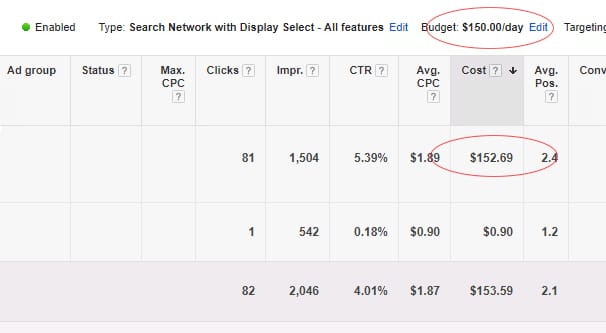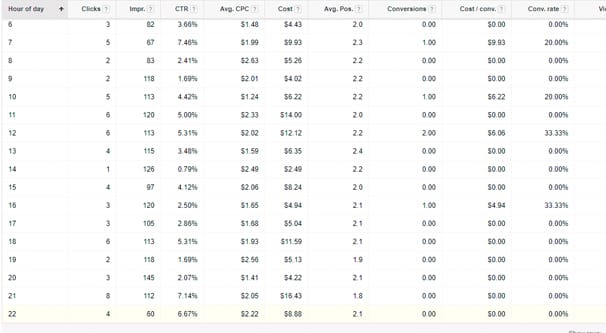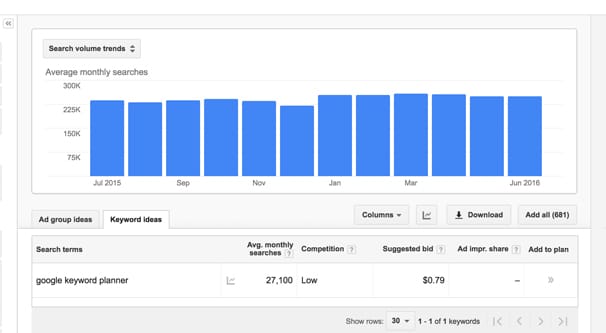Advertising online is one of those things where the more you learn, the more fiddly little bits there are to sink your teeth into. When you’re first starting out, you’re concerned with the big questions. You’re asking things like “should I be running ads” and “how do I organize my ad campaigns, ad sets, and ad groups?”
You get a little more experienced and you start to ask questions about deeper elements of your ads. You wonder when during the day are your best hours for running ads. You start thinking about deeper and more niche ad targeting options. You start split-testing images and bits of ad copy.
Then you start to learn about other aspects of ads that might matter. One such aspect is, when you have daily budget caps on your ads, when do those budgets run out?
Budget Depletion is Important
If you’re new to the concept, you might wonder why this matters. If you have $100 to spend, and you spend $100, that’s good, right? You spend your budget, you get returns from your budget, and that’s that.

If you have $100 to spend, but at the end of the day you’ve only spent $85, it’s a sign that there’s something wrong. If you’re not spending your entire budget, you can make optimizations in a number of ways. You can allow a larger per-ad cap to rank higher in the ad auctions. You can broaden your targeting to reach more people, and spend that budget on more impressions. Overall, this is a good problem to have. What about the opposite, though?
Let’s consider two scenarios.
- You have a total daily budget of $100. On average, your daily budget runs out at 9pm.
- You have a total daily budget of $100. On average, your daily budget runs out at 9am.
Which one is better? In both cases, you’re spending $100 and getting, presumably, $100 worth of traffic.
The problem is with the second scenario. You’re spending your entire budget before many people have even awakened for the day. There’s a massive portion of your audience who never sees your ads, because your budget is running out before they’re browsing the web in your target locations.
What Causes Early Budget Depletion?
If your budget is being depleted too early in the day, there are a few reasons why it might happen.
One reason is having overly broad targeting. If you have very broad targeting and a very wide audience, you can use up your entire budget very quickly, even before peak hours. To look at it another way, you have insufficient budget to reach your target audience. By making a narrower audience, you can refine your budget with better data.
When you refine your audience, you reach more targeted people. Your budget will stretch further, because your ads are more targeted. You end up with a higher quality score, less competition, better costs per impression and costs per conversion. With better returns on your ads, you can end up with more profits, which you can further re-invest into those ads to get yet more returns.
Another reason is having ads with much too high of a cost per action. If you have a high cost per click, and your ad is sufficiently compelling – or reaching a large enough number of people – you can deplete your budget very quickly. This, again, means you’re missing a large portion of your potential audience.

A third possible reason is ads that have a high cost per impression, with low conversions. A high cost per impression with high conversions is fine, so long as the overall cost per conversion is still within an acceptable range. In fact, having a solid cost per conversion while still depleting your budget early means you can expand your budget and still maintain your cost per conversion. On the other hand, if your cost per conversion is too high and you’re depleting your budget too early, you’re hitting inefficiency and wasting money.
Yet another possibility is that your overall budget is being consumed disproportionally by one campaign, rather than being divided equally or proportionally amongst all campaigns. If you have one set of expensive keywords eating up your budget, other keywords – even more efficient or more successful keywords – will be starved for budget.
Why is all of this important? Well, if you’re running out of budget too early, you’re missing a ton of potential visibility and conversions. It’s a sign that you haven’t optimized your ads in a way that reaches the maximum number of people for the minimum cost. In other words, it’s a sign of some tangible improvements you can make.
Finding the Budget Depletion Time
There are a couple of different ways you can discover when your budget is running out each day. The first is to simply check in every hour or so and see how much of your budget has been spent versus how much remains. Make a note of when your budget is running out, or is projected to run out based on how fast it has been spent, and see if that depletion time is within acceptable bounds. Of course, this isn’t a great method, because it means you’re spending a lot of your day refreshing your AdWords analytics. It’s inefficient and it only works for the day you’re checking, not historical data.
Another way is to make sure you have budget alerts enabled. When you have budget alerts enabled, Google will send you an email alert when your budget is depleted for the day. You can then identify when you’re getting those emails, and figure out if you’re running out of budget too early in the day.
If you find that you need to make a custom alert for the job, you might need to dig into some scripting. This post contains a sample script that will send you an email alert when your budget is depleted. It’s a pretty simple script, so you can adjust it to your own ideal metric measurements.
You can also dig into your analytics. Find your campaign data and add/adjust some columns. Under the Dimensions tab, find the Time segment and choose hour of the day. Then find the impression share and identify impressions lost due to budget shortfall. Both of these metrics will show you when you’re running out of money, and how much potential audience you’re losing because of it.

Lost IS, or lost impression share, is the metric you want to find and compare to other metrics for a readout of how much potential visibility you’re losing on a daily/weekly/campaign basis due to insufficient budget. When you compare this metric to other dimensions, you get useful statistics. Compare it to your campaign as a whole to see how much traffic is lost because you can’t reach it. Compare it to time of day to see when each day you’re losing your impression share. Compare it to your ad system as a whole to see if you have one particular set of keywords or ads that are eating up your entire budget, leaving naught but scraps for the rest of them.
Potential AdWords Problems
If you’re running out of budget too early in the day, there are a bunch of different potential mistakes you might be making. Let’s look at common mistakes and see how you might fix them.
#1: You might be using overly broad keywords. For example, imagine if you’re a pet store selling cat toys. If you use a keyword like “cats”, you’re going to reach every query that includes cats. This could be anything from “what toys should I get my cats” all the way to “how to get rid of stray cats.” You have immense potential volume, and very low average relevance.

What you generally want to do is narrow down your keywords. Exact match keywords for your long-tail focus can be useful and important for keeping your audience limited. Phrase match keywords strike a good balance between narrow query targeting and broad audience targeting. In fact, properly using your keywords is itself the subject of many articles, and is an important part of optimizing your ads across all of Google’s platforms.
Remember that the narrower the query, the better the chance you can optimize your copy for specific search intent. That means a better match between customer intent and ad, which means higher click rates and conversion rates, better quality scores, and all-around better metrics. It also means a smaller audience, which means it takes longer to deplete your budget, and you can reach a higher percentage of your audience before depletion.
#2: You might be using accelerated delivery. AdWords delivery comes in two flavors; standard and accelerated. Standard delivery means that Google will strive to show your ads to the most qualified, most narrow selection of users. It means that, in general, your ads will reach the highest quality potential customers and will usually end up with a pretty good cost per conversion. On the other hand, standard delivery also means that you might have surplus budget left over at the end of the day, if too few well-qualified leads come through. It leads to the opposite problem from the one we’re talking about; having too high a budget and not being able to spend it all in a day. As Google says:
- The standard delivery method aims to evenly distribute your budget across the entire day to avoid exhausting your budget early on.
- Accelerated delivery is optimized less. It spends your budget more quickly, usually at the start of the day. Because of this, accelerated delivery isn’t recommended for most advertisers. So if your campaign is limited by budget, your campaign may exhaust its average daily budget early in the day, causing your ad to stop showing for most of the day.
Accelerated delivery prioritizes showing your ads to anyone even potentially qualified, until your budget runs out. If you have a budget surplus, or just want to see how much of a budget it would take to reach your entire target audience, accelerated delivery is ideal. If you have a limited daily budget, however, accelerated delivery means Google spends every penny as quickly as possible, even if that means your entire budget is spent by 9am.

If you’re running into cases where your budget is depleted too early and you’re using accelerated delivery, try switching to standard delivery. Chances are, you’ll get a more even distribution of your budget throughout the day, and can adjust your other settings accordingly.
How do you know when you want to use standard or accelerated? Google recommends standard delivery for most advertisers, as it’s the ideal distribution of budget throughout the day. It’s perfect for small or restricted budgets, but it means you might not see your ads when you go looking for them; it leaves a lot of extra room for competitors in your keywords to reach your audience unless you have a very dominant budget.
On the other hand, accelerated delivery is ideal for two reasons; ads that have an excessive budget that can reach everyone in your target audience with some cash left over, or ads that specifically want to reach people in the morning. A gourmet breakfast restaurant that closes at 1pm doesn’t need to worry about advertising in the evening, and so can use accelerated delivery to reach as much as possible as soon as possible.
That said, you can do temporal restrictions much more easily by setting time to run settings on your ads at the campaign level. Why try to use accelerated delivery to limit your ads to the morning when you can instead just limit them to the morning manually?
#3: You might hate the idea of surplus budget. It’s easy to want to spend your entire budget, and thus poorly optimize your ads just to consume money instead of to get the best returns. A surplus budget means you can expand; an insufficient budget means inefficiency. A surplus is better; it means you can dig in and find ways to spend your money for even more benefit, rather than having to scramble to find more money to spend.
The post Finding The Time Your AdWords Budget is Depleted Each Day appeared first on Growtraffic Blog.
